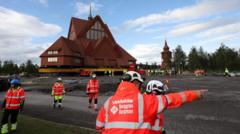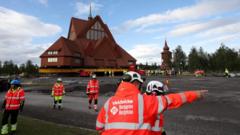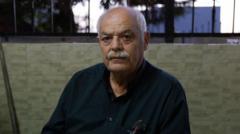The monumental move highlights the town's larger effort to safeguard historical landmarks as mining activities threaten infrastructure.
**Sweden's Kiruna Church Embarks on Historic Relocation Journey**

**Sweden's Kiruna Church Embarks on Historic Relocation Journey**
A 113-year-old church in Kiruna is making a two-day trek to its new city center amid ongoing mining subsidence risks.
The renowned Kiruna Church, a striking timber structure standing for over a century, has begun its remarkable two-day relocation journey across the northern Swedish city to make way for ongoing iron ore mining operations. The church, which dates back to 1912, will be moved a distance of 5 kilometers (around 3 miles) using large rolling platforms, traveling at a pace of up to 500 meters per hour. This extraordinary endeavor has captured the attention of the local community, symbolizing not just a structural shift but also a deep emotional connection to their heritage.
With Kiruna facing threats from ground fissures due to a century-long mining operation, the relocation of the church is part of a larger initiative to preserve other historical buildings in the city at the mercy of subsidence. Culture strategist Sofia Lagerlöf Määttä expressed anticipation for the move, noting, "It's like finally, let's get it done. We've been waiting for so many years."
Stefan Holmblad Johansson, the project manager overseeing the move, highlighted the complexity of this undertaking, emphasizing the lack of room for error. Preparation for such a monumental relocation has spanned several years. Other buildings in Kiruna have already been relocated, some demolished and rebuilt, while key historical sites like the clock tower and residential houses were moved intact.
Under Swedish mining laws, extraction must not occur beneath inhabited structures, as it poses risks to essential community infrastructure including water and sewage services. The city’s mining operator, LKAB, is footing the bill for the relocation, with costs anticipated to exceed 10 billion Swedish krona (approximately $1 billion).
Kiruna Church measures an impressive 35 meters (115 feet) in height and 40 meters in width, weighing over 672 tonnes. Instead of dismantling it, engineers opted for a unique method of transporting the building in one piece, supported by steel beams and self-propelled transporters. To accommodate the building's substantial width, streets have been widened, and certain obstacles along the route, such as lampposts, were removed.
Among the most sensitive considerations during the move is the protection of the church's interior, including an altar painting by Prince Eugen and an organ boasting 1,000 pipes. Project manager Johansson reassured that these treasured items remain secured within the church, fully covered and stabilized for the journey.
The relocation holds immense emotional significance for local residents. Sofia Lagerlöf Määttä recalled her childhood memories associated with the church. "The move has brought back memories of joy and sorrow to us, and we're now moving those memories with us into the future."
Vicar Lena Tjärnberg acknowledged the bittersweet nature of the event, recognizing the church as a cherished symbol of community and spiritual solace. “I'm grateful that we're moving the church with us to the new city center, but there is also sorrow in seeing it leave the ground where it became a church,” she said.
As the church slowly inches forward on its journey, the event is expected to draw significant attention from locals and visitors alike. The move will be broadcast live by Swedish television, marking a rare opportunity for the public to witness history in motion as this beloved landmark transitions to its new home.
With Kiruna facing threats from ground fissures due to a century-long mining operation, the relocation of the church is part of a larger initiative to preserve other historical buildings in the city at the mercy of subsidence. Culture strategist Sofia Lagerlöf Määttä expressed anticipation for the move, noting, "It's like finally, let's get it done. We've been waiting for so many years."
Stefan Holmblad Johansson, the project manager overseeing the move, highlighted the complexity of this undertaking, emphasizing the lack of room for error. Preparation for such a monumental relocation has spanned several years. Other buildings in Kiruna have already been relocated, some demolished and rebuilt, while key historical sites like the clock tower and residential houses were moved intact.
Under Swedish mining laws, extraction must not occur beneath inhabited structures, as it poses risks to essential community infrastructure including water and sewage services. The city’s mining operator, LKAB, is footing the bill for the relocation, with costs anticipated to exceed 10 billion Swedish krona (approximately $1 billion).
Kiruna Church measures an impressive 35 meters (115 feet) in height and 40 meters in width, weighing over 672 tonnes. Instead of dismantling it, engineers opted for a unique method of transporting the building in one piece, supported by steel beams and self-propelled transporters. To accommodate the building's substantial width, streets have been widened, and certain obstacles along the route, such as lampposts, were removed.
Among the most sensitive considerations during the move is the protection of the church's interior, including an altar painting by Prince Eugen and an organ boasting 1,000 pipes. Project manager Johansson reassured that these treasured items remain secured within the church, fully covered and stabilized for the journey.
The relocation holds immense emotional significance for local residents. Sofia Lagerlöf Määttä recalled her childhood memories associated with the church. "The move has brought back memories of joy and sorrow to us, and we're now moving those memories with us into the future."
Vicar Lena Tjärnberg acknowledged the bittersweet nature of the event, recognizing the church as a cherished symbol of community and spiritual solace. “I'm grateful that we're moving the church with us to the new city center, but there is also sorrow in seeing it leave the ground where it became a church,” she said.
As the church slowly inches forward on its journey, the event is expected to draw significant attention from locals and visitors alike. The move will be broadcast live by Swedish television, marking a rare opportunity for the public to witness history in motion as this beloved landmark transitions to its new home.




















